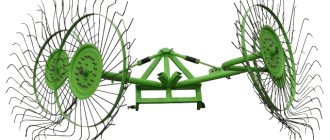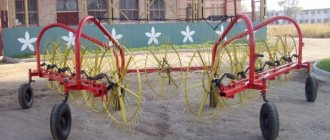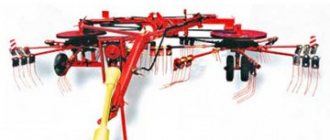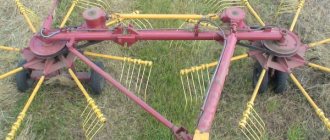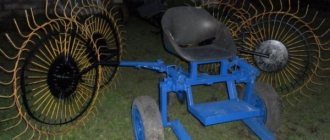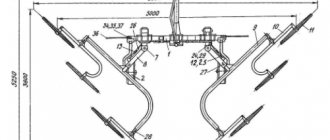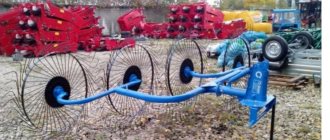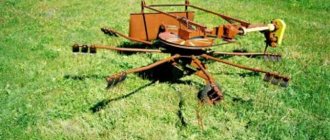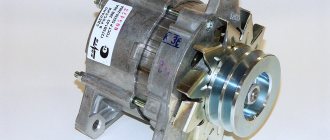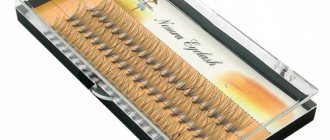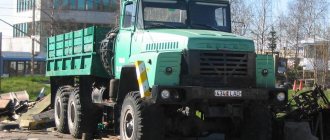Purpose
To simplify the process of collecting hay (on an industrial scale, rakes are not the best option), a unique device was developed - a tedder rake. They are attached to the back of the tractor and allow you to quickly collect all the cut grass. GVK-6 is one of the most common types of this unit. It stands out for its simple design and maintenance. This type of wheel-finger mechanism is equipped with beam impellers with 32 mechanisms on each. This principle allows you to not only drag the hay from place to place, but evenly rake it on both sides at once.
GVK-6 combines three mechanisms:
- Rake raking hay.
- A tedder that turns the dried grass so that it does not rot. Also, with its help you can stir up ready-made windrows.
- The windrower, designed for collecting dried hay, has the possibility of squeezing and compacting.
Peculiarities
The work speed is quite high - about 6 hectares per hour. Unlike its competitors, GVK-6 copes with very wet grass (up to 90%), while all currently existing analogues cannot overcome the moisture threshold of 75%.
Only 1 person is needed to manage and administer the process. Reliability and simplicity of design, as well as the ability to quickly replace the “fingers” are the main advantages of this model.
The mechanism attaches directly to the tractor; no special fastenings are required. The only negative is that the running wheels have average power.
Device
There are two sections installed on the main support frame - left and right. These sections can be used simultaneously or separately. The mechanism moves across the field on support wheels - each section is equipped with three wheels (for movement), as well as five impellers fixed in the direction of movement. These wheels, equipped with a speed regulator, have inclined spring pins.
The rotating control lever will allow you to lower the wheels if the unit does not lift all the grass from the field, or raise them if the rake is buried in the ground. Also, using the lever, the rake is switched to inactive mode (for transportation). In this position, the angle of the fingers changes so that they do not touch foreign objects. This mode allows you to quickly switch without changing the working angle or other settings.
Purpose
To simplify the process of collecting hay (on an industrial scale, rakes are not the best option), a unique device was developed - a tedder rake. They are attached to the back of the tractor and allow you to quickly collect all the cut grass. GVK-6 is one of the most common types of this unit. It stands out for its simple design and maintenance. This type of wheel-finger mechanism is equipped with beam impellers with 32 mechanisms on each. This principle allows you to not only drag the hay from place to place, but evenly rake it on both sides at once.
GVK-6 combines three mechanisms:
- Rake raking hay.
- A tedder that turns the dried grass so that it does not rot. Also, with its help you can stir up ready-made windrows.
- The windrower, designed for collecting dried hay, has the possibility of squeezing and compacting.
Classification
According to the installation method, tedders are divided into two types:
- Wheel-mounted. In this case, the tedder is a series of interconnected wheels, each of which has many hooks for collecting and raking the mown grass or straw.
- Rotary. This subspecies consists of one spinning wheel. Long tubes are attached to it; at the opposite ends of the tubes there are several vertical rods, which reproduce the function of a rake. Such a tedder is capable of quickly turning over and scattering hay to the sides for drying, but it is not suitable for raking into stacks or windrows, since it moves in a circle like a fan, scattering everything to the sides.
Another classification is made into the following groups:
- by the nature of manufacturing of the working part;
- by type of traction;
- by the method of formation of rolls;
- by type of fastening.
They can also be:
- Transverse. The fastening is carried out in such a way that the entire part of the tedder in contact with the ground is located in a position perpendicular to the pulling machine. In this case, it is convenient to perform raking, pulling the mown grass or straw behind the tractor or walk-behind tractor.
- Lateral. In this case, the fastening is made in such a way that the tedder is located diagonally to the pulling machine, that is, it is located on the side. In this position, it is convenient to form windrows from mown grass or straw, which will subsequently be raked with a cross-mounted tedder.
Peculiarities
The work speed is quite high - about 6 hectares per hour. Unlike its competitors, GVK-6 copes with very wet grass (up to 90%), while all currently existing analogues cannot overcome the moisture threshold of 75%.
Only 1 person is needed to manage and administer the process. Reliability and simplicity of design, as well as the ability to quickly replace the “fingers” are the main advantages of this model.
The mechanism attaches directly to the tractor; no special fastenings are required. The only negative is that the running wheels have average power.
What are the advantages
Both rotary and wheeled tractor tedder rakes rake the crop into windrows, making it easier for the baler to bale later. With their help, layers of hay are turned over, exposing the desired side of the windrow to drying under the sun's rays and wind blowing, thereby speeding up the process of drying the hay. Tractor rotary models have good speed and are the optimal tool for working with crops that require careful handling (for example, alfalfa). Also, a tractor with this type of tedder can easily handle wet or heavy hay.
Wheeled tractor tedder rakes are characterized by the highest productivity and work well at high speeds. Their effectiveness is maximum over a long straight distance, but deteriorates in corner areas of the cultivated area. They are easily mounted on the tractor, without requiring the connection of a power take-off shaft for operation.
The fingers on the wheels of such a tedder not only turn over the mown vegetation, but fluff it up, thereby increasing ventilation in the hay windrows. A tractor with a similar attachment processes the field with minimal loss of mown leaves when harvesting hay for forage crops. In addition, such a sun-type design for a small tractor or walk-behind tractor can be made with your own hands.
Device
There are two sections installed on the main support frame - left and right.
These sections can be used simultaneously or separately. The mechanism moves across the field on support wheels - each section is equipped with three wheels (for movement), as well as five impellers fixed in the direction of movement. These wheels, equipped with a speed regulator, have inclined spring pins. The rotating control lever will allow you to lower the wheels if the unit does not lift all the grass from the field, or raise them if the rake is buried in the ground. Also, using the lever, the rake is switched to inactive mode (for transportation). In this position, the angle of the fingers changes so that they do not touch foreign objects. This mode allows you to quickly switch without changing the working angle or other settings.
Design and working process of wheel-finger rake-windrowers GVK-6.0A
A rake can perform several operations - raking hay into windrows, tedding and windrow wrapping.
In addition, on large areas they work in two sections with a coverage of 6 m for raking and 7 m for tedding. In small areas, these operations can be performed in one section. In the transport position, the sections are installed one after another, and the width of the rake will be 2.6_Mi. The general view of the rake is shown in Fig. 152, a. Two sections 4 with impellers 2 are attached to the adjustable coupling, consisting of rods 1 and a welded frame 8. Six impellers are mounted on each section. Two central impellers are mounted on the frame crossbar. The frame of each section is welded and rests on three pneumatic wheels 3. The frame rests on the third, inner wheel through a pipe 7 connected to the frame by curved bars 5 and 6. The impellers on the frame are spring-loaded so that the pressure of the front and middle wheels is approximately 100 —130 N; and the rear ones - 130-160 N. The tension of the springs can be adjusted. The finger wheel (Fig. 152, b) - the main working part of the rake - is made of rim 12, spokes 11, hub and sectors 17. Spring fingers 13 are attached to the sectors. The outer ends of the fingers are passed through the rim and bent against the direction of rotation. The finger wheels of the right and left sections differ in the direction of bending of the fingers. The impeller kit includes a curved axle 15 on which the wheel hub rotates freely. The 16th axis is pivotally connected to the section frame by flange 16. One end of the spring is attached to the axle bracket 14, its other end is attached to the pipe clamp of the impeller lifting mechanism.
The lifting mechanism serves to move the section wheels to transport and working positions. The mechanism is screw, mounted in a pipe on the section frame. When handle 10 is rotated, the pipe moves along the section frame and the spring raises or lowers the impeller. The central impellers are raised and lowered by changing the length of chains passed through the wheel springs. They also regulate the pressure of the central wheel on the soil.
The hitch is used to connect sections and to reconfigure the rake to perform various operations. Rod 1 of adjustable length consists of side braces and two retractable pipes connected to frame 8. The outer ends of the rod are connected to the section frames. Frame 8 is welded; in the front part it has a trailer for connection to the tractor.
The support wheels of the sections are pneumatic, self-aligning and assembled to cast iron hubs.
Still have questions?
www.tehagro.com
Principle of operation and adjustment
The fingers grab the hay as the rake moves. As a result, the impellers begin to move. Grasping the grass occurs at the bottom, at the base, and in the middle part the fingers release them. Due to the inclined position of the wheels, the entire volume of hay constantly moves sideways - from wheel to wheel until it reaches the last one. As a result, we have a voluminous roller that dries quickly, especially in windy weather.
Specifications
- Type of attachment: trailer;
- Classification of traction wheeled tractor: 0.6 - 1.5;
- Gripping radius (when raking and tedding) 6 m;
- Width size 1.16 m;
- Size height 0.30 m;
- Roll density 6.5 kg/m3;
- The distance between the shafts is 4.5 m;
- Total number of fingers 320 pcs.;
- Number of impellers: 10 pcs.;
- Maximum productivity 62000 m2/h;
- Transportation speed 19 km/h;
- Operating speed 12 km/h Weight 0.99 t;
- Transport overall dimensions (length, height, width 7.8x2.5x1.8 m);
- Working overall dimensions 6x1.7x6.5 m.
Modifications
GVK-6.0A
This variety is produced at one of the Ryazan correctional institutions (PKU IK-2). The model boasts compact dimensions and low weight (the smallest among analogues). Slightly inferior to the main model in speed.
- Gripping radius when raking 6 m;
- Gripping radius when tedding 6.2 m;
- Capacity 579600 m2/h;
- Operating speed 10 km/h;
- Weight 0.580 t;
- Transport dimensions (length, height, width) 7.30x1.80x2.0 m;
- Dimensions when raking: 5.8 x 1.63 x 6.65 m;
- Dimensions when tedding: 3.9 x 1.63 x 7.6 m.
GVK-6.0AB
One of the first models produced at the Sol-Iletsk machine-building enterprise. The mechanism is quite heavy – it weighs about a ton. It differs from the basic model in the materials used in manufacturing and in higher productivity.
GVK-6M
This modification is produced by several enterprises: SIMZ LLC, as well as the Belagro partner network, which unites manufacturers from different CIS countries. Their mechanisms differ slightly in weight. For models from SIMZ LLC it is 725 kg, and for analogues from Belagro – 775 kg.
- Transport dimensions (length, height, width) 2.5x1.70x1.8 m;
- Dimensions when raking 6.6x1.65x6 m Dimensions when tedding 7.5x1.60x4.0 m.
How to make a rake - tedder with your own hands?
First, we need to make a metal frame, the dimensions of which will directly depend on the traction of the walk-behind tractor or walk-behind tractor. But it can be made from a metal pipe of round or square cross-section. We make one side of the frame the same size as the hinge, and gradually narrow the other.
To operate the tedder rotor, a cardan shaft is required, but the rear axle of a passenger car can also be used as a cardan shaft (the fact is that the rear axle of a car has all the necessary gears for operation).
If the tedder you are going to make is intended for a tractor, you will also have to install a reduction gearbox on the power take-off shaft.
On many tractors, the number of revolutions per minute is 540, which is, of course, a lot for tedders.
As a rotor, you can use a car disk, on which 10 tubes are welded to create a “sun”.
Now we are making teeth for rakes, in the manufacture of which it is recommended to use durable steel. We weld them to the rotor and at this point we can assume that our rotary tedders are ready.
Owner reviews
Since rakes are designed for large-scale agricultural work, they are purchased mainly by farmers or cultivators for whom speed and low cost of cultivating the land are important, because doing such work manually is time-consuming and expensive.
Mikhail Hello, I want to share my experience of using GVK-6. The task was to clear and prepare the site for construction. The idea came to mind to sell the hay in the same way. It's a small thing, but nice. While I was making an estimate, I was looking for workers to assemble it, I came across an interesting offer, I thought that GVK-6 would be more expensive, but it could be used in the future or rented out. As for the site itself, I am pleased with the result. Fast, high-quality, without unnecessary secondary costs and operations. I recommend.
Price
The new unit will cost the buyer 75-80 thousand rubles, depending on the region. The lowest prices are in Ryazan and Chelyabinsk, the closer to Moscow and the region, the more expensive. Used ones can be purchased for 50 thousand or less. Don't be afraid of low prices for used rakes. As mentioned above, even a serious breakdown can be dealt with by yourself by returning the device to its working position.
The domestic manufacturer has proven by its own example that our technologies can well compete with Western developments. Simplicity and reliability are what lies at the heart of the GVK-6. For entrepreneurs and farmers who value their time and money, this is a must-have purchase.
How do you like the article?
